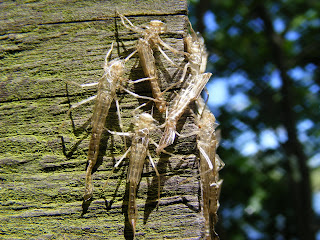
Hatching time to birdy people means lots of baby birds. Our cygnets and goslings are appearing now and most birds have big chicks or are on their second brood. However, the spectacular event this week is the emergence of millions of damselflies. There are clouds of them in the air. Armies of nymphs are marching from the water to a suitable post where they can get up in the breeze and hatch. They all look the same at first; green, then pale grey with weak wings. After a few hours in this teneral form, they take on the bright blue of the adults. Most are common blues and azure damselflies, but near Cloudy Pit you may find red-eyed and even small red-eyed damsels.
I photographed some damsels hatching at the Kingfisher Hide and spotted a caddis fly there too. They hatch from the surface of the water and come to the trees to harden up.
 Later, on my way back to the office, I came across a group of photographers gathered around a bush. The focus (pun!) of their interest seemed to be a hornet which was sunning on a leaf. However, it turned out to be a moth that imitates a hornet. It's called a hornet clear-wing moth. It lays its eggs on the base of poplar trees and the larvae live under the bark. You can often see the holes where the fat larvae have emerged at the base of the trunk. Unfortunately, these holes allow disease into the tree and we have had to call the tree surgeon ion to treat several of our large poplars in the last year. It's an amazing piece of evolutionary mimicry though.
Later, on my way back to the office, I came across a group of photographers gathered around a bush. The focus (pun!) of their interest seemed to be a hornet which was sunning on a leaf. However, it turned out to be a moth that imitates a hornet. It's called a hornet clear-wing moth. It lays its eggs on the base of poplar trees and the larvae live under the bark. You can often see the holes where the fat larvae have emerged at the base of the trunk. Unfortunately, these holes allow disease into the tree and we have had to call the tree surgeon ion to treat several of our large poplars in the last year. It's an amazing piece of evolutionary mimicry though.